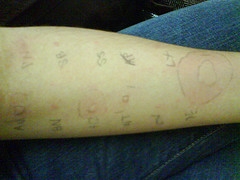Finding Out about Hives

Hives are a common side effect to a number of allergic reactions and those who get them all react differently. In medical circles, these hives are a skin condition called urticaria. One hive is considered a symptom of this urticaria, but as most people develop more than one hive bump, thus the name hives.
Any location on the body is fair game to developing hives. However, the soles of the feet and palms of the hands are usually spared because the skin is tougher in these areas.
Hives can happen to anyone, no matter the age, race or sex. They can also occur at any time of the year. About 1/5 of the population has had hives, at least once, or for some, it is a chronic condition.
What Hives Look Like
Hives look like red round bumps that have a spongy appearance which can change appearance quickly. The area around a hive can be red which doctors call a flare. Hives can vary in size from a millimeter or two to large bumps that cover the entire body.
Causes can vary when it comes to hives; however the underlying biological process is the same. The capillaries dilate which allows fluid to leak into the surrounding areas of the epidermis. Once the hives start fading, this excess fluid is then reabsorbed into the body. Hives do not leave a sore or blister on the surface of the skin. Rather, they have this fluid leakage below the outer surface of the skin. When you press on a hive bump, the area will whiten around it.
Hives Can Itch
Hives are quite itchy and this is because of all of the nerve endings at the surface of the epidermis, where the fluid leakage and swelling occurs. Some people experience very little itching. Others itch so much, they feel like taking a wire brush to their hives. One version of hives called angioedema does not typically cause itching, because it affects the deeper skin tissues and even the lining of the stomach, larynx and more.
The release of histamine occurs when hives form. Histamine is contained within certain white blood cells which are then released when certain triggers occur. These triggers can be virtually anything. Allergic reactions are common.
You may break out in hives, if you eat shellfish and you are allergic. A thyroid condition or sinus infection could trigger hives.
Some people get hives after excessive exercise or even a sudden drop in temperature. There are a variety of causes that can induce hives as well.
Most cases of hives can be treated with the same parameters however, regardless of the trigger. Antihistamines are the first line of defense since it is histamines that are released to cause the hives. Over the counter antihistamines like Benadryl can work, but your doctor could prescribe something without drowsiness side effects.
For serious cases of hives, epinephrine may be used. However, its effects are short-term and are usually used in conjunction with a severe allergic reaction. All in all, there are quite a few causes of hives and just as many treatment options.
[phpbay]allergy hives, 7, “”, “”[/phpbay]
Finding Out about Hives related articles from the blogosphere…
Possibly related posts: